Northfield Telecommunications d b a Advanced Wireless Communications HD-1000V2 Two-Way Radio User Manual 1
Northfield Telecommunications, Inc. d/b/a Advanced Wireless Communications Two-Way Radio 1
user manual
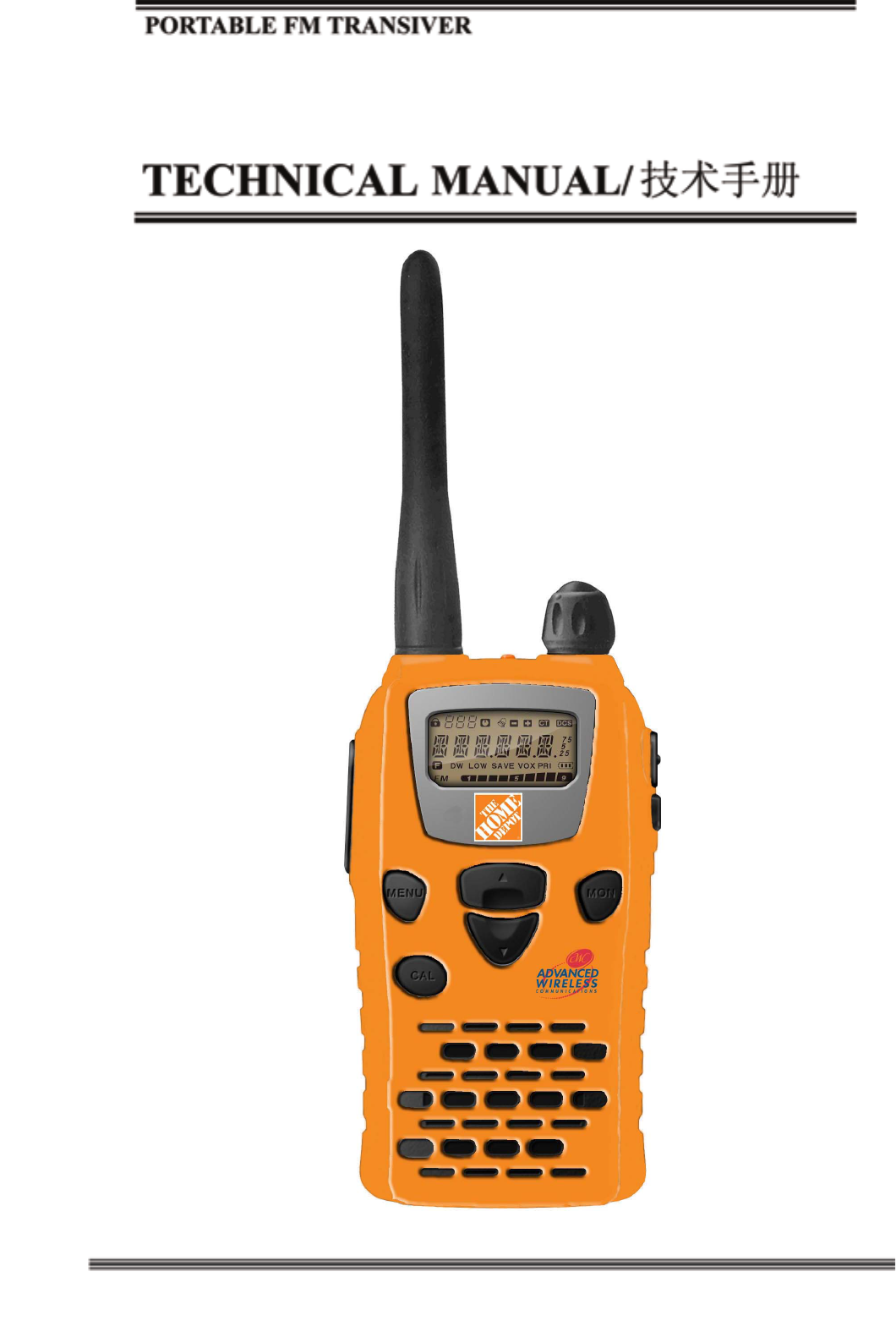
HD-1000V2

GENERAL/概述
INTRODUCTION
SCOPE OF THIS MANUAL
familiar with similar types of commercial grade communications
equipment. It contains all required service information for the
equipment and is current as of the publication date.Changes
Bulletins or Manual Revisions. These are issued as required.
ORDERING REPLACEMENT PARTS
When ordering replacement parts or equipment information,
applies to all parts: components, kits, or chassis. If the part
component for proper identification.
PERSONAL SAFETY
The following precautions are recommended for personal safety:
• DO NOT transmit until all RF connectors are verified secure
and any open connectors are properly terminated.
•
blasting caps or in an explosive
•This equipment should be serviced by a qualified technician
only.
SERVICE
This radio is designed for easy servicing. Refer to the schematic
diagrams, printed circuit board views, and alignment procedures
contained within.
0.5W/1W
0.5W/1W
引言
本手册的范围
本手册是提供给熟悉通信专业并且具有维修经验的技术人员
使用的。
替换零件的订购
当订购替换零件或设备信息时,应注明完整的零件识别号码。
所有的零件均有识别号码:元件、组件或机壳。如果不知道
零件的号码,为了正确地识别,必须注明此元件所属的机壳
或组件的号码,并对元件进行充分的说明。
个人安全
为了个人的安全,请注意下列事项:
•在没有认真核实所有射频插头之前或有任何一个打开的插头
没有连接到响应端子上的情况下,均不要发射。
•在电爆管附近或在易燃性气体环境中,必须关掉电源,不要
操作本设备
•本设备只应该由有资格的技术人员来维修。
维修服务
为了便于维修本设备,建立了完整的维修服务体系,提供了
包括原理图、印刷线路图和调整步骤在内的资料供参考。
信道数量
射频输出功率
RF Power Output
Number of channels
This manual is intended for use by experienced technicians
which may occur after publication are covered by either Service
它包括了维修该设备所 需要的全部资料和现行公布
后可能发生变动,如果需要,可以使用《维修
the full part identification number should be included.This
number is not known, include the chassis or kit number of
SHUT OFF and DO NOT operate this equipment near electrical
which it is a part, and a sufficient description of the required
的数据。在出版
通报》或《手册修订本》
进行补充。
199 199
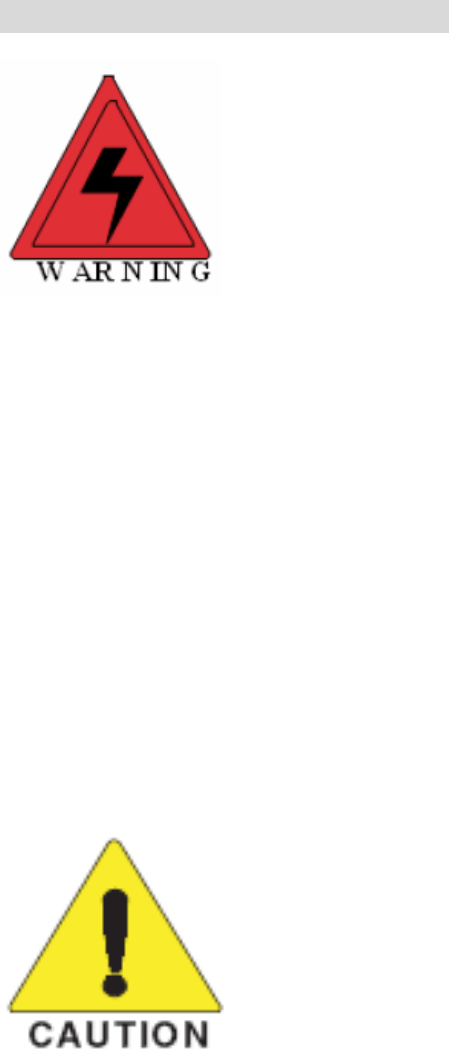
SAFETYTRAINING INFORMATION
Your radio generates RF electromagnetic energy during
transmit mode. This radio is designed for and classified as
“Occupational Use Only”, meaning it must be used only during
the course of employment by individuals aware of the hazards,
and the ways to minimize such hazards. This radio is NOT
intended for use by the “General Population” in an uncontrolled
environment.
This radio has been tested and complies with the FCC RF exposure limits for
“Occupational Use Only”. In addition, your radio complies with the following
Standards and Guidelines with regard to RF energy and electromagnetic energy levels
and evaluation of such levels for exposure to humans:
FCC OET Bulletin 65 Edition 97-01 Supplement C, Evaluating Compliance with FCC
Guidelines for Human Exposure to Radio Frequency Electromagnetic Fields.
American National Standards Institute (C95.1-1992), IEEE Standard for Safety Levels
with Respect to Human Exposure to Radio Frequency Electromagnetic Fields, 3 kHz
to 300 GHz.
American National Standards Institute (C95.3-1992), IEEE Recommended Practice
for the Measurement of Potentially Hazardous Electromagnetic Fields– RF and
Microwave.
The following accessories are authorized for use with this product. Use of accessories
other than those (listed in the instruction) specified may result in RF exposure levels
exceeding the FCC requirements for wireless RF exposure.
To ensure that your expose to RF electromagnetic
energy is within the FCC allowable limits for
occupational use, always adhere to the following
guidelines:
DO NOT operate the radio without a proper antenna attached, as this may damaged
the radio and may also cause you to exceed FCC RF exposure limits. A proper
antenna is the antenna supplied with this radio by the manufacturer or antenna
specifically authorized by the manufacturer for use with this radio.
DO NOT transmits for more than 50% of total radio use time (“50%duty cycle”).
Transmitting more than 50% of the time can cause FCC RF exposure compliance
requirements to be exceeded. The radio is transmitting when the “TX indicator” lights
red. You can cause the radio to transmit by pressing the “PTT” switch.
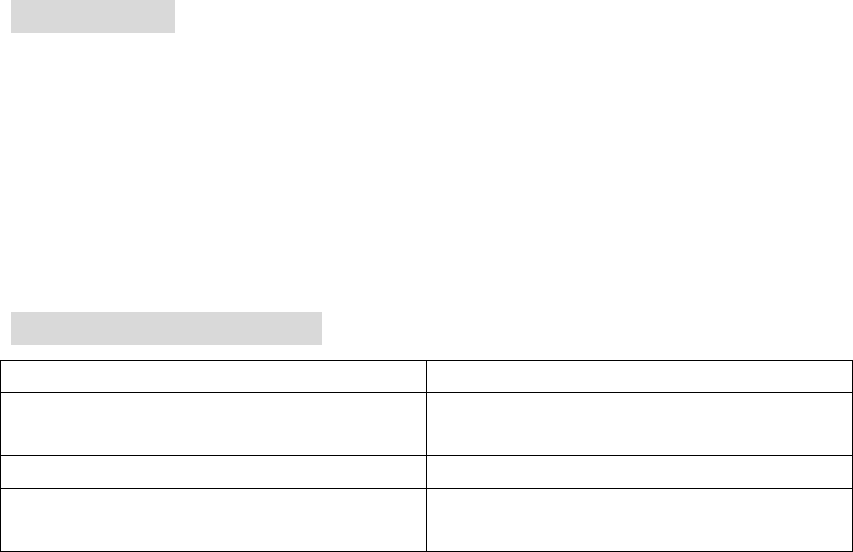
ALWAYS keep the antenna at least 2.5 cm (1 inch) away from the body when
transmitting and only use the belt-clip which is listed in instructions when
attaching the radio to your belt, etc., to ensure FCC RF exposure compliance
requirements are not exceeded. To provide the recipients of your transmission the
best sound quality, hold the antenna at least 5 cm (2 inches) from your mouth, and
slightly off to one side.
The information listed above provides the user with the information needed to make him
or her aware of RF exposure, and what to do to as-sure that this radio operates with the
FCC RF exposure limits of this radio.
Electromagnetic Interference/Compatibility
During transmissions, your radio generates RF energy that can possibly cause
interference with other devices or systems. To avoid such interference, turn off the radio in
areas where signs are posted to do so. DO NOT operate the transmitter in areas that are
sensitive to electromagnetic radiation such as hospitals, aircraft, and blasting sites.
Occupational/Controlled Use
The radio transmitter is used in situations in which persons are exposed as consequence
of their employment provided those persons are fully aware of the potential for exposure
and can exercise control over their exposure.
IMPORTANT
READ ALL INSTRUCTIONS carefully and completely before using the
transceiver
SAVE THIS INSTRUCTION MANUAL- This instruction manual contains
important operating instructions for the Two-Way Radio
EXPLICIT DEFINITIONS
WORD DEFINITION
WARNING Personal injury, fire hazard or electric shock
may occur.
CAUTION Equipment damage may occur.
NOTE If disregarded, inconvenience only. No risk
of personal injury, fire or electric shock.

OPERATING NOTES
When transmitting with a portable radio, hold the radio in a vertical position with its
microphone 5 to 10 cm (2 to 4 inches) away from your mouth. Keep the antenna at
least 2.5 cm (1 inch) from your head and body.
If you wear a portable two-way radio on your body, ensure that the antenna is at least
2.5 centimeters (1 inch) from your body when transmitting.
PRECAUTIONS
WARNING! NEVER hold the transceiver so that the antenna is very close to, or touching
exposed parts of the body, especially the face or eyes, while transmitting. The transceiver
will perform best if the microphone is 5 to 10 cm (2 to 4 inches) away from the lips and the
transceiver is vertical.
WARNING! NEVER operate the transceiver with a headset or other audio accessories at
high volume levels.
CAUTION! NEVER short the terminals of the battery pack.
NEVER connect the transceiver to a power source other than the Battery listed below
Such a connection will ruin the transceiver.
DO NOT push the PTT when not actually desiring to transmit.
AVOID using or placing the transceiver in direct sunlight or in areas with temperatures
below –30°C (–22°F) or above +60°C (+140°F).
DO NOT modify the transceiver for any reason.
MAKE SURE the flexible antenna and battery pack are securely attached to the
transceiver, and that the antenna and battery pack are dry before attachment. Exposing
the inside of the transceiver to water will result in serious damage to the transceiver.
BE CAREFUL! The series transceivers employ waterproof construction, which
corresponds to IPX7 of the international standard IEC 60529 (2001), 1 m depth for 30
minutes. However, once the transceiver has been dropped, waterproofing cannot be
guaranteed due to the fact that the transceiver may be cracked, or the waterproof seal
damaged, etc.
The use of non-Advanced battery packs/chargers may impair transceiver performance
and invalidate the warranty.
FCC CAUTION:
Changes or modifications to this device, not expressly approved by Manufacturer,
could void your authority to operate this transceiver under FCC regulations.
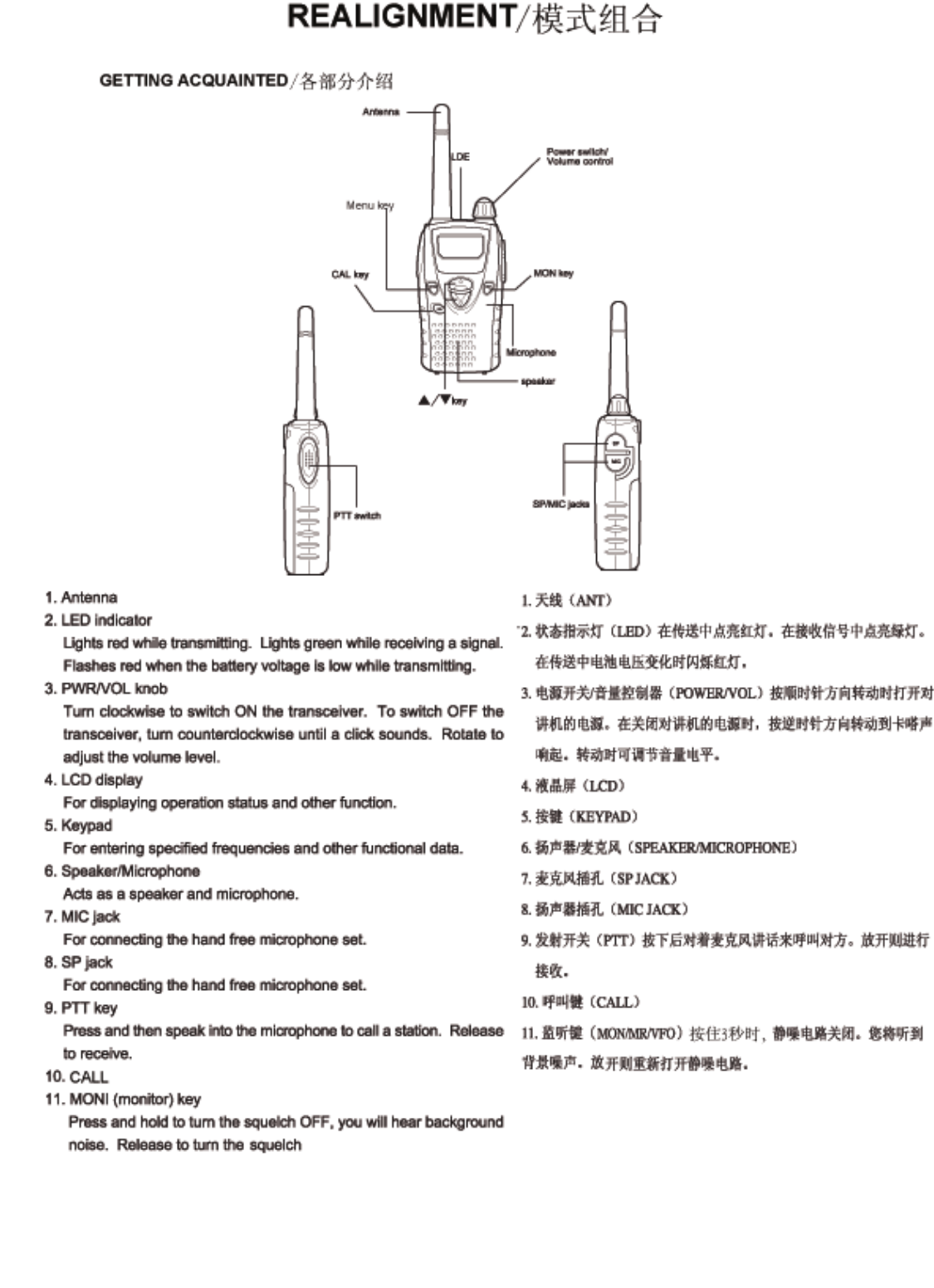
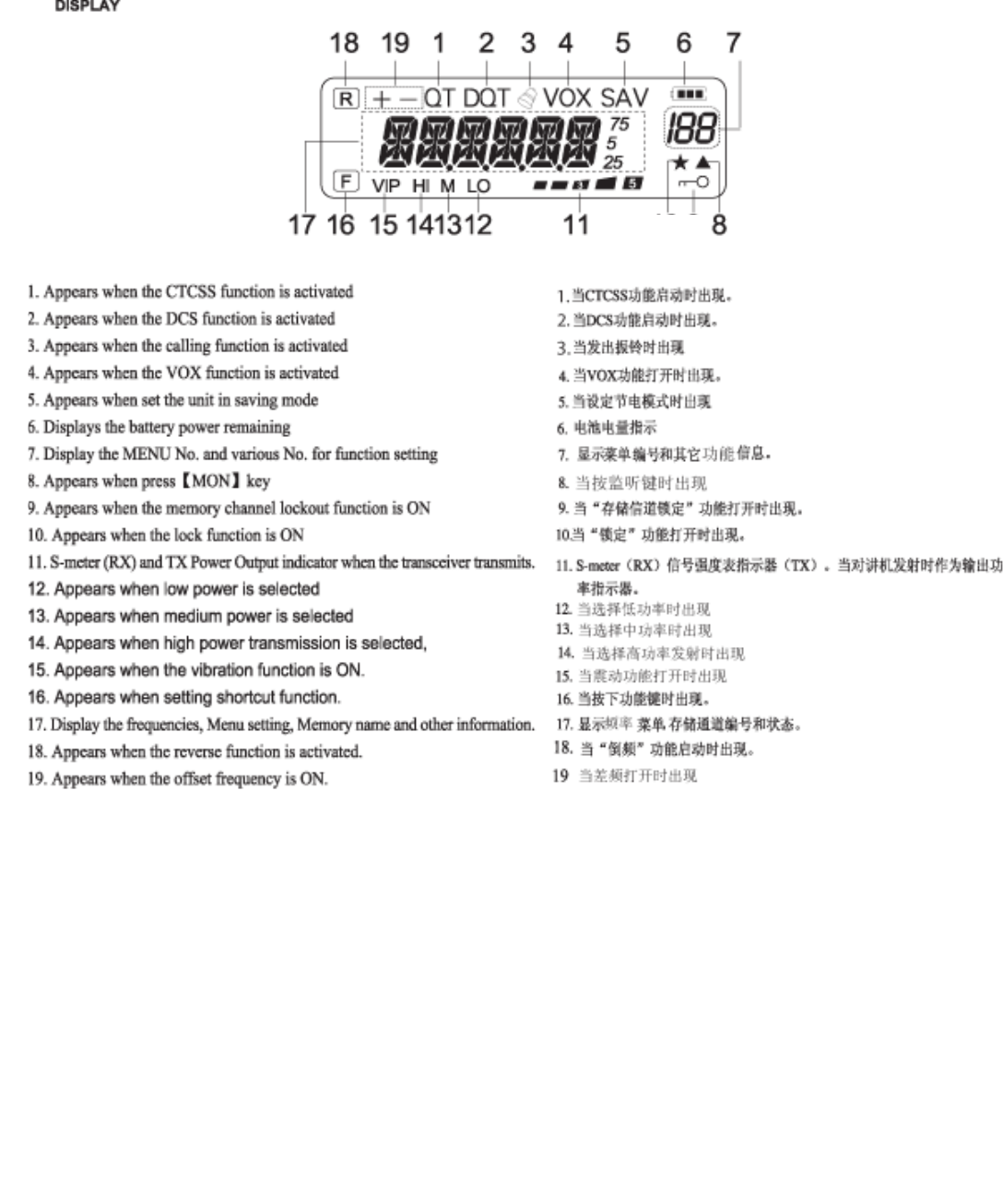
910
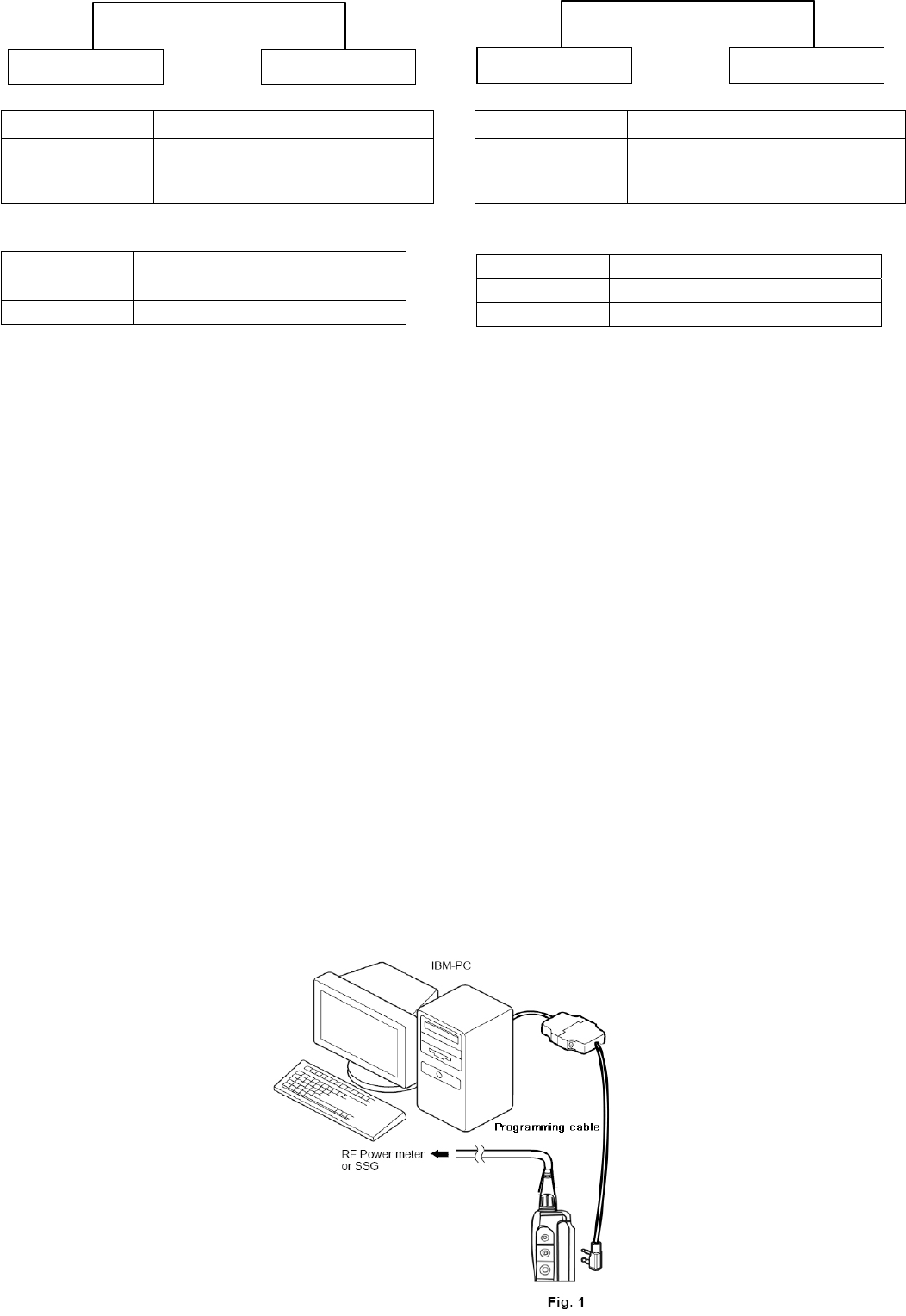
MODES
USER MODE PC MODE
模式
用户模式 PC模式
MODES
User mode
PC mode
PC mode
Power ON
PROCEDURE
Used for communication between the radio
and a PC
How to enter each mode
MODES
PC MODE
Preface
The HD-1000 transceiver can be programmed using a personal
The programming software can be used on an IBM
Caution:
When removing or installing the programming cable,
first
switch off the radio power.
Additionally, be sure to disable the VOX function, if
it’s enabled, as it can sometimes activate from connection
noise.
Connection procedure
1. Connect the HD-1000 to the personal Computer using the
interface cable.
2. When the POWER is switched ON, you can enter user mode.
Programming software description
The software allows a user to program the HD-1000 radios via
the
• Programming with IBM PC
If data is transferred to the transceiver from a PC with the software,
the destination data (basic radio information) for each set can be
modified.
For normal use.
FUNCTION
用户模式
计算机模式
Used for communication between the radio
and a PC
用于普通操作
功能
模式类型
User mode
Receiver commands from PC
模式类型 操作步骤
用户模式
计算机模式
打开电源开关
从计算机接收命令
software.
PC or compatible. Fig-1 shows the setup of a PC for programming.
programming interface cable.
计算机模式
前言
通过个人电脑,使用编程电缆和编程软件,对对讲机HD-1000
进行编程设置。图1表示一台IBM计算机的编程设置过程。
注意
当拔除或者插入编程电缆首先关闭对讲机电源。另外,确保声
控功能已关闭,如果声控被激活,可能有时会开启连接噪音。
连接步骤
1.使用接口电缆将HD-1000与个人电脑连接。
2.当电源开关打开,可以进入用户模式。
编程软件说明
该软件允许用户经由编程接口电缆对HD-1000进行编程设定。
使用IBM计算机编程
如果从使用软件的IBM计算机将数据发送到手持机,设定的目的
数据(基本通信参数)均可被修改。
computer, A programming interface cable and programming
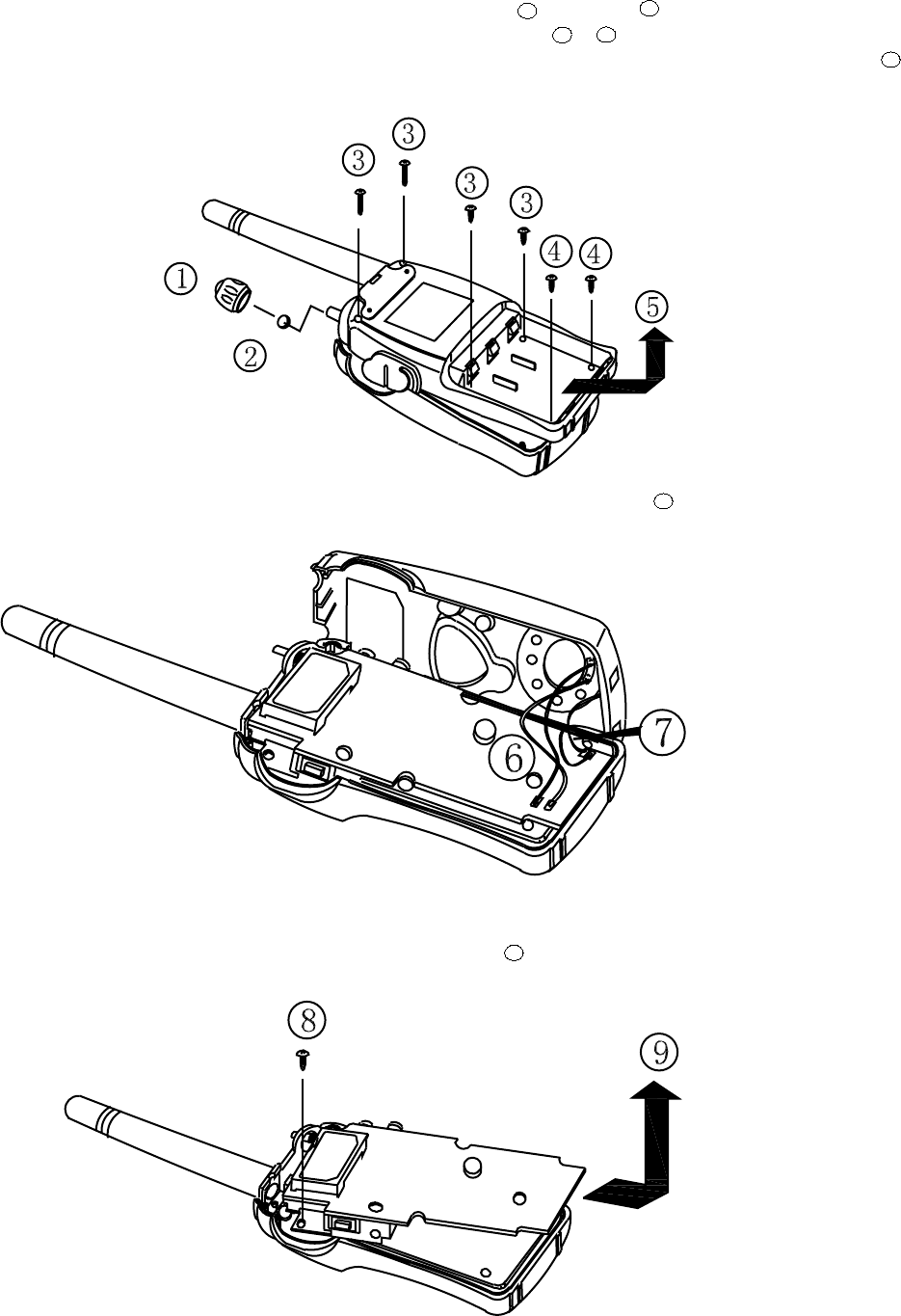
DISASSEMBLY FOR REPAIR/维修时拆卸部分
Separating the case assembly from the chassis
1. Remove the knob 1 and the round nut 2
2. Remove the six screws 3 and 4
3. Expand the right and left sides of the bottom
it from the case assembly 5.
4. Taking care not to cut the speaker lead 7,
Remove the screws 8 and drop-out line,
of the case assembly, lift the chassis,and
open
and lift
从底座上分离外壳
1.取下旋扭 1和环形螺母
2.取下六颗螺钉
3.掀开外壳底部的左右两侧,取下底座,并外壳中取出
2
43
5
4.小心不要折断扬声器引线
7,拆下底座和外壳。
底座从主板上分离
然后取下主板.
,
8
remove
the chassis and case assembly.
the first unit off.
取下螺钉
Separating the chassis from the unit
和
FCC ID: Q9SHD-1000V2
IC: 4651A-HD1000V2
NOTE: This equipment has been tested and found to comply with the limits for a
Class A digital device, pursuant to Part 15 of the FCC Rules. These limits are
designed to provide reasonable protection against harmful interference when the
equipment is operated in a commercial environment. This equipment generates, uses,
and can radiate radio frequency energy and, if not installed and used in accordance
with the instruction manual, may cause harmful interference to radio communications.
Operation of this equipment in a residential area is likely to cause harmful
interference in which case the user will be required to correct the interference at his
own expense.